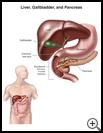
Gallbladder Removal: Laparoscopic Cholecystectomy
________________________________________________________________________
KEY POINTS
- A laparoscopic cholecystectomy is a surgery to remove your gallbladder using a lighted tube with a camera which is passed into the belly through small cuts in the belly wall.
- You may need this surgery if you have cancer, gallstones, or severe scarring or damage to your gallbladder.
- Ask your provider how long it will take to recover and how to take care of yourself at home.
- Make sure you know what symptoms or problems you should watch for and what to do if you have them.
________________________________________________________________________
What is a laparoscopic cholecystectomy?
A laparoscopic cholecystectomy is a surgery to remove your gallbladder using a lighted tube with a camera which is passed into the belly through small cuts in the belly wall.
The liver and gallbladder are part of your digestive system. The liver makes bile that helps your body break down the fat in food. Ducts carry bile to the gallbladder and small intestine. The gallbladder is a small sac under your liver on your right side that stores bile.
When is it used?
Your gallbladder may need to be removed if you have:
- Gallstones or a serious infection in your gallbladder. Gallstones are hard stone-like objects that build up in the gallbladder. If stones completely block the gallbladder or bile duct, the flow of bile out of the liver can also be blocked. This causes swelling, irritation, and pain in your liver, your gallbladder, or both. If not treated, swelling can cause your gallbladder to burst, or you could get a serious infection. Both can be life-threatening.
- Damage to your gallbladder from an accident or a long-term illness
How do I prepare for this procedure?
- Plan for your care and find someone to give you a ride home after the procedure.
- Your healthcare provider will tell you when to stop eating and drinking before the procedure. This helps to keep you from vomiting during the procedure.
- Follow your healthcare provider's instructions about not smoking before and after the procedure. Smokers may have more breathing problems during the procedure and heal more slowly. It is best to quit 6 to 8 weeks before surgery.
- You may or may not need to take your regular medicines the day of the procedure. Tell your healthcare provider about all medicines and supplements that you take. Some products may increase your risk of side effects. Ask your healthcare provider if you need to avoid taking any medicine or supplements before the procedure.
- Tell your healthcare provider if you have any food, medicine, or other allergies such as latex.
- Follow any other instructions your healthcare provider gives you.
- Ask any questions you have before the procedure. You should understand what your healthcare provider is going to do. You have the right to make decisions about your healthcare and to give permission for tests or procedures.
What happens during this procedure?
The procedure will be done at the hospital.
You will be given medicine called anesthesia to keep you from feeling pain. General anesthesia relaxes your muscles and puts you into a deep sleep during the procedure.
Your healthcare provider will make several small cuts in the belly. Air will be passed into your intestines so your provider can see as much of the area as possible.
Your provider will use a lighted tube with a camera called a laparoscope to help see inside the belly. Other instruments will be passed through the other cuts. Your provider will remove the gallbladder. Your provider will then close the cuts in your belly.
What happens after this procedure?
You may be able to leave the hospital later the same day. In some cases you may need to stay overnight. Removal of your gallbladder should cause few, if any, long-term problems because your digestive system can work well without it. You may have looser bowel movements after its removal.
Follow your healthcare provider's instructions. Ask your provider:
- How long it will take to recover
- If there are activities you should avoid and when you can return to your normal activities
- How to take care of yourself at home
- What symptoms or problems you should watch for and what to do if you have them
Make sure you know when you should come back for a checkup. Keep all appointments for provider visits or tests.
What are the risks of this procedure?
Every procedure or treatment has risks. Some possible risks of this procedure include:
- You may have problems with anesthesia.
- You may have infection, bleeding, or blood clots.
- Other parts of your body may be injured during the procedure.
Ask your healthcare provider how the risks apply to you. Be sure to discuss any other questions or concerns that you may have.

